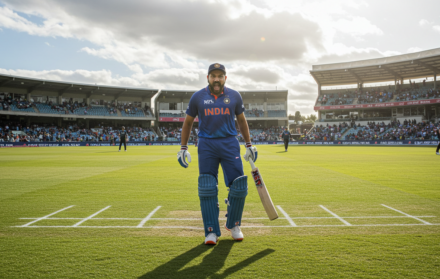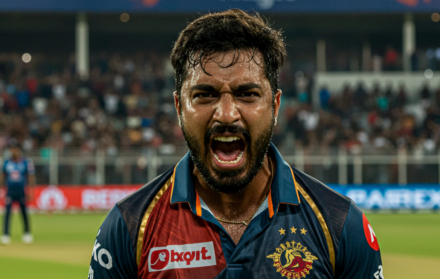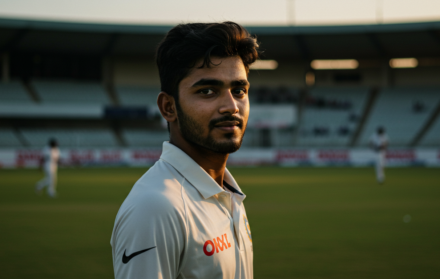
How To Prepare For Longer Game Formats With Cricket Endurance Training
Preparing for longer game formats in cricket requires a focused and strategic approach, particularly when it comes to endurance training. Cricket endurance training is crucial for players who aim to excel in extended matches, ensuring they maintain peak performance throughout the game. This article will guide you through the essential aspects of endurance training for cricket, helping you build the stamina and resilience needed for success in longer formats.
Endurance training in cricket goes beyond simple physical fitness; it encompasses a range of activities designed to enhance stamina, strength, and overall conditioning. One of the primary aspects of endurance training is understanding the role of proper nutrition and hydration. Incorporating the right cricket nutrition and hydration products for players can significantly impact endurance levels and recovery times during and after games. Learn more about these products by visiting cricket nutrition and hydration products for players.
To build endurance, it’s essential to engage in consistent and varied physical training routines. Cricket fitness equipment for training plays a vital role in developing the necessary strength and stamina for longer matches. These tools and exercises can help enhance specific muscle groups and improve overall fitness levels. Explore effective training tools and techniques at cricket fitness equipment for training.
In addition to physical conditioning, mental preparation is equally important for enduring longer game formats. Developing a strong mental approach to cricket can help players maintain focus and resilience during extended periods of play. Techniques to build mental strength are discussed in detail at how to develop a strong mental approach to cricket bowling.
Effective cricket endurance training also involves drills and exercises that simulate match conditions. Engaging in cricket drills to improve hand-eye coordination is critical for maintaining performance levels over long periods. These drills help players develop the skills needed to stay sharp and responsive during intense matches. Learn about effective drills at cricket drills to improve hand-eye coordination.
Furthermore, understanding the impact of weather conditions on cricket is essential for preparing for longer game formats. Different weather conditions can affect players’ endurance and performance, requiring specific strategies to adapt. Insight into how weather affects cricket can be found at weather conditions affect a cricket match.
Recovery techniques are a crucial part of endurance training, ensuring that players can bounce back quickly after intense sessions and matches. Implementing effective recovery strategies, such as those outlined in recovery techniques for cricket bowlers, can help maintain long-term performance levels.
Lastly, integrating data analytics into your training regimen can provide valuable insights into your performance and areas for improvement. Utilizing data analytics for bowling strategy, for example, can enhance your understanding of how to maintain consistency and efficiency in your game. Explore the benefits of data-driven training at data analytics for bowling strategy.
By incorporating these aspects into your cricket endurance training routine, you can build the physical and mental resilience needed to excel in longer game formats. From nutrition and fitness equipment to mental strategies and recovery techniques, each element plays a vital role in preparing for extended matches. Embrace these training methods to enhance your endurance and elevate your cricket performance to new heights.
Cardiovascular Training for Cricket Endurance

Cardiovascular fitness is the foundation of endurance training for cricket. A strong cardiovascular system allows players to maintain high energy levels and recover quickly between bursts of intense activity. Here are some effective cardiovascular exercises for cricket endurance:
Running is a fundamental exercise for building cardiovascular endurance. Long-distance running helps build aerobic capacity, while interval training with sprints improves anaerobic fitness and recovery. A combination of steady-state runs and high-intensity interval training (HIIT) can be highly effective. For example, cricketers can include 30-minute steady runs twice a week and HIIT sessions with short sprints followed by recovery periods.
Cycling and swimming are excellent low-impact cardiovascular exercises that enhance endurance without putting excessive strain on joints. These activities also provide variety to the training routine, which can help prevent boredom and overuse injuries. Incorporating cycling or swimming sessions into the weekly training schedule can improve overall cardiovascular fitness.
Rowing and skipping are great alternatives to traditional running workouts. Rowing machines provide a full-body workout that boosts cardiovascular endurance and strengthens muscles. Skipping, or jump rope, improves footwork, coordination, and cardiovascular fitness. Including these exercises in the training regimen can add diversity and challenge different muscle groups.
A balanced cardiovascular training program, incorporating running, cycling, swimming, rowing, and skipping, helps build the stamina needed to endure the physical demands of long cricket matches.
Strength and Conditioning for Cricket Endurance
Strength and conditioning play a pivotal role in enhancing cricket endurance. Building muscle strength and improving overall conditioning allow players to perform consistently at high levels without succumbing to fatigue. Here are some key strength and conditioning exercises for cricket endurance:
Resistance training, including weightlifting and bodyweight exercises, helps build muscle strength and endurance. Exercises such as squats, deadlifts, lunges, and bench presses target major muscle groups, improving overall power and stability. Incorporating resistance training into the routine two to three times a week can significantly enhance muscular endurance and performance.
A strong core is essential for maintaining balance, stability, and posture during long matches. Core strengthening exercises such as planks, Russian twists, leg raises, and medicine ball slams help develop the muscles around the abdomen, lower back, and pelvis. A strong core supports efficient movement patterns and reduces the risk of injuries.
Plyometric exercises, also known as jump training, improve explosive power and agility. These exercises include box jumps, burpees, and jump squats. Plyometric training enhances the ability to perform quick, powerful movements, which is crucial for fast bowlers and fielders who require bursts of speed and strength.
Flexibility and mobility exercises, such as yoga and dynamic stretching, are essential for maintaining a full range of motion and preventing injuries. Regularly practicing these exercises helps keep muscles and joints flexible and reduces the risk of strains and sprains. Including yoga or stretching sessions in the weekly routine promotes recovery and overall physical well-being.
A comprehensive strength and conditioning program that incorporates resistance training, core strengthening, plyometric exercises, and flexibility work ensures that cricketers are physically prepared to handle the demands of longer game formats.
Mental Training and Resilience Building

Mental toughness is as important as physical endurance in cricket. The ability to stay focused, handle pressure, and make strategic decisions is crucial for success in longer formats. Here are some effective mental training techniques for building resilience and mental endurance:
Visualization involves creating mental images of successful performance and positive outcomes. Cricketers can use this technique to mentally rehearse their batting, bowling, or fielding skills. By visualizing successful scenarios, players can build confidence and reduce anxiety. Regular practice of visualization helps condition the mind for high-pressure situations.
Mindfulness and meditation practices help improve focus, concentration, and emotional control. Techniques such as deep breathing, progressive muscle relaxation, and mindfulness meditation can reduce stress and enhance mental clarity. Practicing mindfulness regularly helps players stay present and composed during long matches, enhancing their ability to make clear decisions under pressure.
Setting clear, achievable goals provides direction and motivation for training and performance. Cricketers should set both short-term and long-term goals related to their endurance training and match performance. Breaking down larger goals into smaller, manageable steps helps maintain motivation and track progress. Positive self-talk and affirmations also boost confidence and resilience.
Incorporating mental toughness drills into training sessions helps players develop resilience. These drills can simulate high-pressure situations, such as batting in the final overs of a match or bowling in challenging conditions. Practicing under simulated stress conditions helps players build the mental fortitude needed to perform well in real match scenarios.
Combining visualization, mindfulness, goal setting, and mental toughness drills in the training regimen helps cricketers develop the mental resilience required to excel in longer game formats.
Nutrition and Hydration for Endurance
Proper nutrition and hydration are critical components of endurance training for cricket. Fueling the body with the right nutrients and maintaining hydration levels ensure sustained energy and optimal performance throughout long matches. Here are some key nutritional and hydration strategies for cricket endurance:
A balanced diet that includes a mix of carbohydrates, proteins, and healthy fats is essential for providing sustained energy. Carbohydrates are the primary fuel source for endurance activities, so including complex carbs like whole grains, fruits, and vegetables is crucial. Proteins support muscle repair and recovery, while healthy fats provide long-lasting energy. Cricketers should aim to consume a variety of nutrient-dense foods to meet their energy needs.
Eating the right foods before a match helps maximize energy stores and enhance performance. A pre-match meal should be consumed 3-4 hours before the game and include a balance of carbohydrates, proteins, and fats. Examples include grilled chicken with quinoa and vegetables or a pasta dish with lean meat and a side salad. Additionally, a light snack, such as a banana or an energy bar, can be consumed 30-60 minutes before the match to maintain energy levels.
Staying hydrated is essential for maintaining physical and cognitive function. Cricketers should drink water regularly throughout the day, aiming for at least 8-10 glasses daily. During matches, it’s important to drink fluids at regular intervals to replace the fluids lost through sweat. Sports drinks that contain electrolytes can be beneficial during long matches to maintain electrolyte balance and prevent dehydration.
Consuming small, easily digestible snacks during breaks helps maintain energy levels. Options include fruit, energy bars, nuts, and hydration drinks. These snacks provide quick energy and help sustain performance throughout the match. It’s also important to continue hydrating during breaks to avoid fatigue and maintain focus.
Proper nutrition after a match aids in recovery and prepares the body for future training and matches. A post-match meal should include a combination of carbohydrates and proteins to replenish glycogen stores and support muscle repair. Examples include a smoothie with protein powder, fruits, and yogurt, or a balanced meal with lean meat, brown rice, and vegetables. Rehydrating with water or electrolyte drinks is also crucial for recovery.
Maintaining a balanced diet, staying hydrated, and following proper nutrition strategies before, during, and after matches ensure that cricketers have the energy and stamina needed for optimal performance in longer game formats.
Rest and Recovery for Optimal Performance

Rest and recovery are essential components of an effective endurance training program. Proper rest allows the body to repair and strengthen itself, preventing injuries and enhancing performance. Here are some key strategies for rest and recovery:
Sleep is crucial for physical and mental recovery. Cricketers should aim for 7-9 hours of quality sleep each night to allow the body to repair muscles, consolidate memory, and rejuvenate energy levels. Establishing a regular sleep routine and creating a conducive sleep environment, such as a cool, dark, and quiet room, can improve sleep quality.
Active recovery involves low-intensity activities that promote blood flow and muscle relaxation. Examples include walking, light jogging, swimming, or yoga. Active recovery sessions help reduce muscle soreness and stiffness, enhancing overall recovery. Incorporating active recovery into the training schedule ensures that the body remains active without adding excessive strain.
Stretching and foam rolling help maintain flexibility, improve blood circulation, and reduce muscle tension. Static stretching after training sessions and matches helps elongate muscles and prevent tightness. Foam rolling targets muscle knots and trigger points, promoting muscle relaxation and recovery. Regular stretching and foam rolling routines enhance overall mobility and reduce the risk of injuries.
Massage therapy can aid in muscle recovery and relaxation. Regular massages help release muscle tension, improve circulation, and reduce stress. Cricketers can benefit from professional sports massages or use self-massage tools like foam rollers and massage balls to target specific muscle groups.
Proper hydration and nutrition play a significant role in recovery. Replenishing fluids lost during training and matches is essential for maintaining optimal performance. Consuming a balanced diet rich in proteins, carbohydrates, and healthy fats supports muscle repair and recovery. Including antioxidant-rich foods, such as berries and green leafy vegetables, helps reduce inflammation and oxidative stress.
Mental relaxation techniques, such as meditation, deep breathing, and mindfulness, help reduce stress and promote mental recovery. Incorporating these techniques into the daily routine helps cricketers manage anxiety, enhance focus, and maintain a positive mindset. Mental relaxation contributes to overall well-being and prepares players for the mental demands of long matches.
Prioritizing rest and recovery ensures that cricketers can sustain high levels of performance, reduce the risk of injuries, and maintain overall physical and mental health. Integrating these strategies into the training regimen supports optimal performance in longer game formats.
Creating a Comprehensive Endurance Training Plan
Developing a comprehensive endurance training plan tailored to the demands of cricket is essential for success in longer game formats. Here are key components to include in an effective training plan:
Start by assessing the current fitness level and setting specific, measurable goals. Identify areas of strength and areas that need improvement. Setting both short-term and long-term goals provides direction and motivation. Regular assessments help track progress and adjust the training plan as needed.
Design a balanced training schedule that includes cardiovascular exercises, strength and conditioning, flexibility and mobility work, and mental training. Ensure that the schedule allows for adequate rest and recovery. A well-rounded training program addresses all aspects of endurance, enhancing overall performance.
Incorporate a variety of exercises and training methods to keep the routine engaging and prevent plateauing. Gradually increase the intensity, duration, and complexity of workouts to promote continuous improvement. Progression ensures that the body adapts and builds endurance over time.
Regularly monitor training progress and make necessary adjustments. Use tools like fitness trackers, training logs, and performance assessments to gather data. Adapt the training plan based on feedback, ensuring it remains effective and aligned with goals.
Consider seeking guidance from fitness trainers, nutritionists, and sports psychologists. Professional support provides expert advice, personalized training plans, and strategies for overcoming challenges. Collaborating with professionals enhances the effectiveness of the training program.
Consistency and commitment are key to achieving endurance goals. Stick to the training plan, stay motivated, and maintain a positive mindset. Consistent effort and dedication lead to significant improvements in endurance and overall performance.
Creating a comprehensive endurance training plan that includes assessment, balanced training, variety, monitoring, professional guidance, and commitment ensures that cricketers are well-prepared for the demands of longer game formats.
Elevate Your Game: Effective Cricket Endurance Training for Longer Formats

Preparing for longer game formats in cricket requires a holistic approach to endurance training. By focusing on cardiovascular fitness, strength and conditioning, mental resilience, proper nutrition, and effective rest and recovery strategies, cricketers can build the stamina and toughness needed to excel in extended matches.
Cardiovascular fitness is the cornerstone of endurance training, enabling cricketers to maintain high energy levels throughout long matches. Incorporating activities like running, cycling, and interval training into your routine helps improve heart and lung capacity, ensuring sustained performance on the field.
Strength and conditioning are equally important, as they enhance muscle endurance and overall physical robustness. Regular weight training and bodyweight exercises target key muscle groups, improving power and reducing the risk of injury. Plyometric exercises can also boost explosive strength, essential for quick movements and dynamic plays.
Mental resilience plays a crucial role in enduring long matches. Techniques such as mindfulness, visualization, and mental conditioning exercises help cricketers stay focused, manage stress, and maintain concentration during critical moments. Developing mental toughness ensures players can perform consistently under pressure.
Proper nutrition fuels the body for extended periods of physical activity. A balanced diet rich in carbohydrates, proteins, and healthy fats provides the necessary energy and nutrients. Hydration is also key to maintaining peak performance and preventing fatigue. Tailoring your diet to meet the demands of longer games can significantly enhance endurance and recovery.
Effective rest and recovery strategies are vital for maintaining long-term performance and well-being. Adequate sleep, active recovery sessions, and regular massages help the body repair and rejuvenate. Implementing these strategies ensures cricketers can train consistently without the risk of burnout or overtraining.
Developing a comprehensive training plan that integrates these elements is essential for success. Consistency and commitment to the training process lead to significant improvements in performance and overall well-being. Monitoring progress and adjusting the plan as needed ensures that training remains effective and aligned with individual goals.
In conclusion, embracing endurance training techniques is crucial for cricketers aiming to excel in longer game formats. By focusing on cardiovascular fitness, strength and conditioning, mental resilience, proper nutrition, and effective rest and recovery strategies, players can elevate their game and thrive in the challenging and rewarding world of cricket. Commit to a holistic training approach to build the stamina and toughness needed for success in extended matches, and enjoy the significant benefits that come with enhanced endurance and performance.





